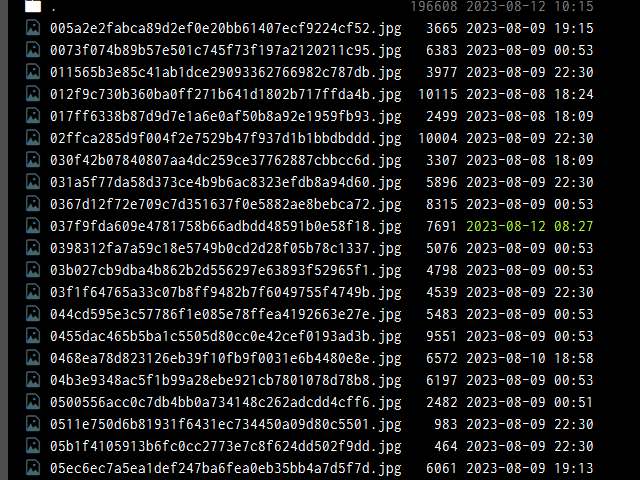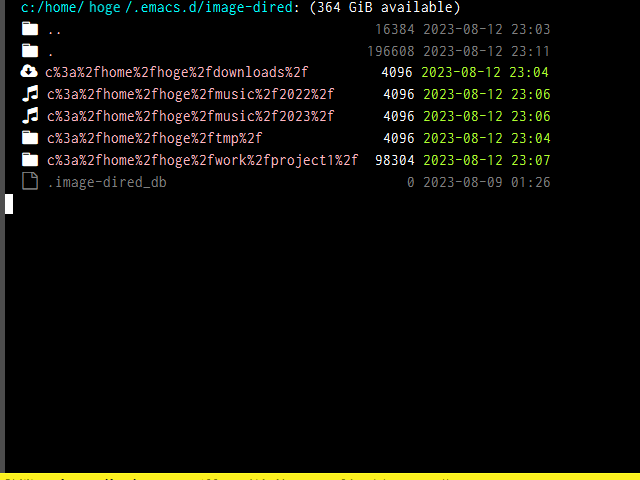前回の続き。image-diredが生成するサムネイルを元の画像の場所が分かるような形式にしたのでした(image-dired-thumbnail-storage が 'image-dired-dir のときの話)。
image-diredのサムネイルを元の画像の場所が分かる形式にする(2023-08-17修正あり)
今回はこの仕組みを使って、不要になったサムネイルを削除するコマンドを作ります。
まずサムネイルのパスから元の画像の場所を求める関数を作成します。
;;;; サムネイルファイル名のデコード (defun my-image-dired--decode-thumb-name (str) "STR内の%xx表記を元の文字に戻します。" (replace-regexp-in-string "%[0-9A-Fa-f][0-9A-Fa-f]" (lambda (entity) (char-to-string (string-to-number (substring entity 1) 16))) str t t)) (defun my-image-dired-thumb-original-file-name (thumb-path) "サムネイル画像THUMB-PATHの元画像ファイルのファイル名(ディレクトリ 部分を含まない)を返します。" (my-image-dired--decode-thumb-name (file-name-sans-extension ;;jpgを取り除く (file-name-nondirectory thumb-path)))) (defun my-image-dired-thumb-original-dir (thumb-path) "サムネイル画像THUMB-PATHの元画像ファイルがあるディレクトリを返します。" (setq thumb-path (expand-file-name thumb-path)) (unless (string-prefix-p (expand-file-name (image-dired-dir)) thumb-path) (error "THUMB-PATH is not in the `image-dired-dir'")) (my-image-dired--decode-thumb-name (file-name-nondirectory (directory-file-name (file-name-directory thumb-path))))) (defun my-image-dired-thumb-original-path (thumb-path) "サムネイル画像THUMB-PATHの元画像ファイルへのパスを返します。 元画像ファイルは存在しているとは限りません。" (file-name-concat (my-image-dired-thumb-original-dir thumb-path) (my-image-dired-thumb-original-file-name thumb-path)))
そしてこれらを使って元の画像が既に無くなっているサムネイルを削除するコマンドを作りました。
;;;; サムネイルの掃除 (defvar my-image-dired-clean-verbose nil) (defun my-image-dired-clean-thumbs-dir (thumbs-dir &optional forced-delete-p) "サムネイルが格納されているディレクトリTHUMBS-DIR内を掃除します。 THUMBS-DIRは`my-image-dired--thumb-dir'で作成されたような、元のディ レクトリが%エンコードされているパスです。その下にあるファイルは `my-image-dired--thumb-file-name'でエンコードされている必要があり ます。 FORCED-DELETE-Pがnon-nilの時は、元画像がまだあるサムネイルも含め て全てのサムネイルが削除されます。" (let ((original-dir (my-image-dired-thumb-original-dir (file-name-as-directory thumbs-dir))) (valid-count 0) (deleted-count 0) (error-count 0)) (dolist (thumb-path (directory-files thumbs-dir t "\\.jpg\\'")) (let* ((original-filename (my-image-dired-thumb-original-file-name thumb-path)) (original-path (file-name-concat original-dir original-filename))) (if (and (not forced-delete-p) (file-exists-p original-path)) ;; 有効なサムネイルが存在した。 (cl-incf valid-count) ;; 無効なサムネイルを消す。 (when my-image-dired-clean-verbose (message "Delete thumb %s (Original:%s)" thumb-path original-path)) (condition-case err (progn (delete-file thumb-path) (cl-incf deleted-count)) (error (when my-image-dired-clean-verbose (message "Failed to delete thumb %s (Original:%s) err=%s" thumb-path original-path err)) (cl-incf error-count)))))) ;; 有効なサムネイルが存在しないならディレクトリの削除を試みる。 (when (= valid-count 0) (when my-image-dired-clean-verbose (message "Delete thumbs dir %s" thumbs-dir)) (ignore-errors (delete-directory thumbs-dir))) ;; 結果を返す。 (my-image-dired-clean-count-make deleted-count error-count valid-count))) ;; 処理結果の意味 (defun my-image-dired-clean-count-make (&optional deleted error valid) (list (or deleted 0) (or error 0) (or valid 0))) (defun my-image-dired-clean-count-inc (dst src) (cl-loop for dst-cell on dst for src-value in src do (setcar dst-cell (+ (car dst-cell) src-value)))) (defun my-image-dired-clean-count-deleted (count) (nth 0 count)) (defun my-image-dired-clean-count-error (count) (nth 1 count)) (defun my-image-dired-clean-count-valid (count) (nth 2 count)) (defun my-image-dired-clean-report (count show-msg) (when show-msg (message "Deleted %s, Error %s, Valid %s" (my-image-dired-clean-count-deleted count) (my-image-dired-clean-count-error count) (my-image-dired-clean-count-valid count))) count) (defun my-image-dired-clean-thumbs (&optional forced-delete-p) "既に存在しない画像に対するサムネイルを削除します。" (interactive) ;; `image-dired-dir'下の全てのディレクトリについて ;; `my-image-dired-clean-thumbs-dir'を呼び出す。 (let ((thumbs-root-dir (image-dired-dir)) (count (my-image-dired-clean-count-make))) (dolist (file (directory-files thumbs-root-dir)) (when (not (member file '("." ".."))) (let ((thumbs-dir (expand-file-name file thumbs-root-dir))) (when (file-directory-p thumbs-dir) (my-image-dired-clean-count-inc count (my-image-dired-clean-thumbs-dir thumbs-dir forced-delete-p)))))) (my-image-dired-clean-report count (called-interactively-p 'interactive)) count))
ディレクトリを限定して、お掃除をするコマンドも追加します。
(defun my-image-dired-clean-thumbs-under (original-dir &optional subdirs-p forced-delete-p) "ORIGINAL-DIR下の画像に対するサムネイルのうち不要になったものを削除します。 SUBDIRS-Pがnon-nilの場合、ORIGINAL-DIR以下にあった子孫ディレクト リも処理に含めます。 インタラクティブに実行した場合は、現在のディレクトリが original-dirになり、コマンドのプレフィックス引数がsubdirs-pになり ます。" (interactive (list (if (derived-mode-p 'dired-mode 'wdired-mode) (dired-current-directory) ;;複数のディレクトリを表示している場合に備えて default-directory) current-prefix-arg)) (let ((thumbs-dir (my-image-dired--thumb-dir (file-name-as-directory original-dir))) (count (my-image-dired-clean-count-make))) (if subdirs-p ;; 子孫ディレクトリを含める。 ;; エンコードしたディレクトリパスと先頭がマッチする ;; サムネイルディレクトリを全て対象にする。 ;; 既に削除されているディレクトリも列挙できる。 (dolist (thumbs-dir (directory-files (image-dired-dir) t (concat "\\`" (regexp-quote (file-name-nondirectory thumbs-dir))))) (my-image-dired-clean-count-inc count (my-image-dired-clean-thumbs-dir thumbs-dir forced-delete-p))) ;; 指定ディレクトリ下のみ。 (when (file-directory-p thumbs-dir) (setq count (my-image-dired-clean-thumbs-dir thumbs-dir forced-delete-p)))) (my-image-dired-clean-report count (called-interactively-p 'interactive)) count))
ついでに無条件でサムネイルを削除するコマンドも追加しておきます。
(defun my-image-dired-delete-thumbs () "全てのサムネイルを削除します。" (interactive (unless (yes-or-no-p "Delete all thumbnails? ") (keyboard-quit))) (my-image-dired-clean-report (my-image-dired-clean-thumbs t) (called-interactively-p 'interactive))) (defun my-image-dired-delete-thumbs-under (original-dir &optional subdirs-p) "ORIGINAL-DIR下の画像に対するサムネイルを全て削除します。 SUBDIRS-Pがnon-nilの場合、ORIGINAL-DIR以下にあった子孫ディレクト リも処理に含めます。 インタラクティブに実行した場合は、現在のディレクトリが original-dirになり、コマンドのプレフィックス引数がsubdirs-pになり ます。" (interactive (list (if (derived-mode-p 'dired-mode 'wdired-mode) (dired-current-directory) ;;複数のディレクトリを表示している場合に備えて default-directory) current-prefix-arg)) (my-image-dired-clean-report (my-image-dired-clean-thumbs-under original-dir subdirs-p t) (called-interactively-p 'interactive)))
これで次の4つのコマンドが出来ました。
- my-image-dired-clean-thumbs : 元の画像が無くなったサムネイルを削除
- my-image-dired-clean-thumbs-under : 同ディレクトリ指定バージョン
- my-image-dired-delete-thumbs : 無条件でサムネイルを削除
- my-image-dired-delete-thumbs-under : 同ディレクトリ指定バージョン
無条件削除はdiredで~/.emacs.d/image-diredを開いて手動で削除すればいい気もするんですけどね。一応。
cleanやclean-underをいつ呼び出すかは残された問題です。一括サムネイル表示コマンド(image-dired-show-all-from-dirや私の改造版だとmy-image-dired-dired-show-all-thumbsとか)に仕込んでおくくらいでしょうか? いや、ファイル数が多いディレクトリではあまり良くない? 最悪手動で呼び出すしかないですね。そのあたりは好き好きで。
後は許容容量に応じて古くなったサムネイルを削除する機能とか。「古くなった」と一口に言ってもそれはどういう意味なのか。最終アクセス日時情報が取れないと難しいところはあります。まぁ、その辺はもういいかなーという気もします。結局気が向いたときにdiredで~/.emacs.d/image-diredを開いて消せば良いのでしょう。MD5ハッシュだとそれすら簡単には出来ないので前回・今回の改造は意義があることでしょう。
それにしても本家はこの辺りどうするつもりなんでしょうね。タグやコメントでは~/.emacs.d/image-dired/.image-dired_dbというファイルを作って記録するので、結局その延長で対応表ファイルを作るくらいなのかなーと予想しますが。

